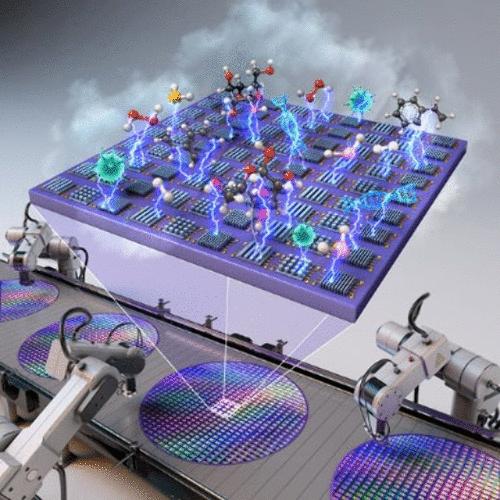当前位置:
X-MOL 学术
›
Acc. Mater. Res.
›
论文详情
Our official English website, www.x-mol.net, welcomes your
feedback! (Note: you will need to create a separate account there.)
Top-Down Fabrication of Chemical and Biological Sensors
Accounts of Materials Research ( IF 14.0 ) Pub Date : 2024-08-28 , DOI: 10.1021/accountsmr.4c00170 Hohyung Kang 1 , Ahyeon Cho 1 , Seongcheol Park 2 , Soo-Yeon Cho 2 , Hee-Tae Jung 1
Accounts of Materials Research ( IF 14.0 ) Pub Date : 2024-08-28 , DOI: 10.1021/accountsmr.4c00170 Hohyung Kang 1 , Ahyeon Cho 1 , Seongcheol Park 2 , Soo-Yeon Cho 2 , Hee-Tae Jung 1
Affiliation

|
Fabrication of complex three-dimensional (3D) structures with micro/nanoscale dimensions is crucial for high-performing chemical and biological sensor applications. It not only enables the accurate detection and tracking of minuscule chemical and biological analytes but also determines the commercial viability and practical utilization of the sensors in future intricate applications. Among various structure fabrication approaches, top-down lithography provides invaluable tools for fabricating complex 3D micro/nanoscale structures in sensors, enabling the sensitive and selective detection of low concentration chemical and biological analytes. Moreover, it preserves the inherent advantages of top-down lithography as the sensor attributes, including (i) high-resolution and tight pitch 3D structures in long-range order, (ii) varied pattern shapes, dimensions, and densities, (iii) low device-to-device variation, (iv) high integrated circuit yield, (v) acceptable process cost and processability, and (vi) the ability to accommodate a wide range of materials. Given the variety of top-down lithographic methods available for fabricating sensors and the complex requirements of the sensor such as diverse target analytes, varying concentration levels, and different sensing environments, it is essential to have a comprehensive understanding of the technical nuances associated with each top-down lithography technique and its applications. However, there is a significant gap in the literature regarding targeted evaluations of top-down lithography methods for high-performance chemical and biological sensor fabrication as well as a clear articulation of sensor design rules.
中文翻译:

化学和生物传感器的自上而下的制造
制造具有微米/纳米级尺寸的复杂三维 (3D) 结构对于高性能化学和生物传感器应用至关重要。它不仅可以准确检测和跟踪微小的化学和生物分析物,还可以确定传感器在未来复杂应用中的商业可行性和实际用途。在各种结构制造方法中,自上而下的光刻技术为在传感器中制造复杂的 3D 微/纳米级结构提供了宝贵的工具,能够灵敏和选择性地检测低浓度化学和生物分析物。此外,它保留了自上而下光刻技术作为传感器属性的固有优势,包括 (i) 高分辨率和长距离顺序的紧密间距 3D 结构,(ii) 不同的图形形状、尺寸和密度,(iii) 低器件间差异,(iv) 高集成电路产量,(v) 可接受的工艺成本和可加工性,以及 (vi) 适应各种材料的能力。鉴于可用于制造传感器的自上而下光刻方法多种多样,并且传感器的要求复杂,例如不同的目标分析物、不同的浓度水平和不同的传感环境,因此必须全面了解与每种自上而下光刻技术及其应用相关的技术细微差别。然而,关于对用于高性能化学和生物传感器制造的自上而下的光刻方法的针对性评估以及传感器设计规则的明确阐述,文献中存在重大差距。
更新日期:2024-08-28
中文翻译:

化学和生物传感器的自上而下的制造
制造具有微米/纳米级尺寸的复杂三维 (3D) 结构对于高性能化学和生物传感器应用至关重要。它不仅可以准确检测和跟踪微小的化学和生物分析物,还可以确定传感器在未来复杂应用中的商业可行性和实际用途。在各种结构制造方法中,自上而下的光刻技术为在传感器中制造复杂的 3D 微/纳米级结构提供了宝贵的工具,能够灵敏和选择性地检测低浓度化学和生物分析物。此外,它保留了自上而下光刻技术作为传感器属性的固有优势,包括 (i) 高分辨率和长距离顺序的紧密间距 3D 结构,(ii) 不同的图形形状、尺寸和密度,(iii) 低器件间差异,(iv) 高集成电路产量,(v) 可接受的工艺成本和可加工性,以及 (vi) 适应各种材料的能力。鉴于可用于制造传感器的自上而下光刻方法多种多样,并且传感器的要求复杂,例如不同的目标分析物、不同的浓度水平和不同的传感环境,因此必须全面了解与每种自上而下光刻技术及其应用相关的技术细微差别。然而,关于对用于高性能化学和生物传感器制造的自上而下的光刻方法的针对性评估以及传感器设计规则的明确阐述,文献中存在重大差距。






























 京公网安备 11010802027423号
京公网安备 11010802027423号